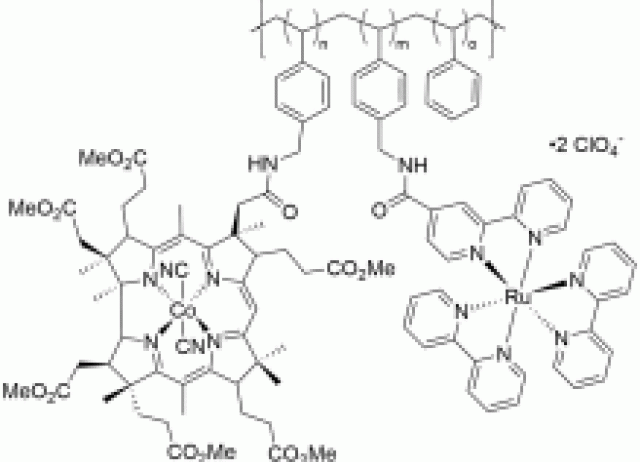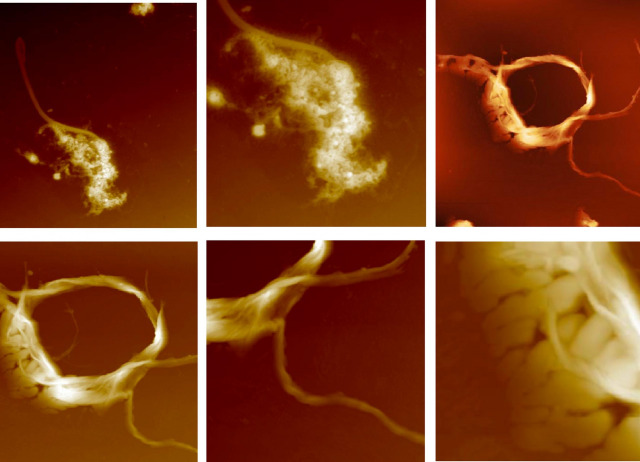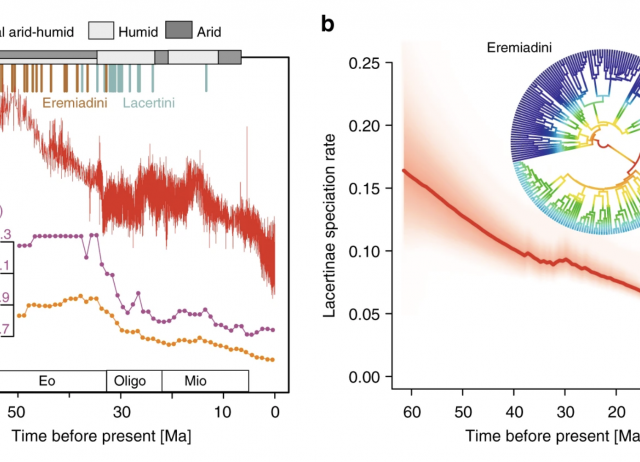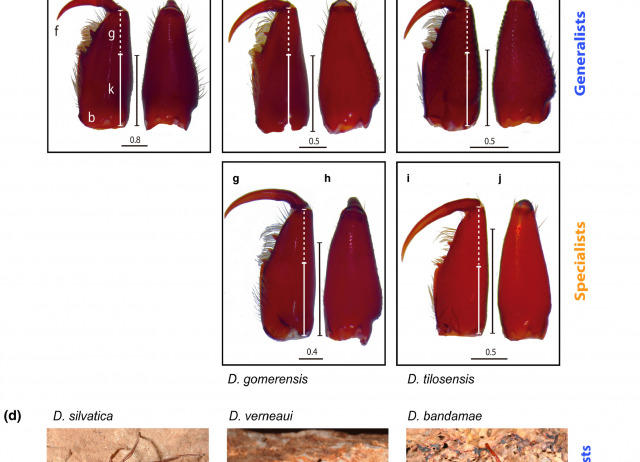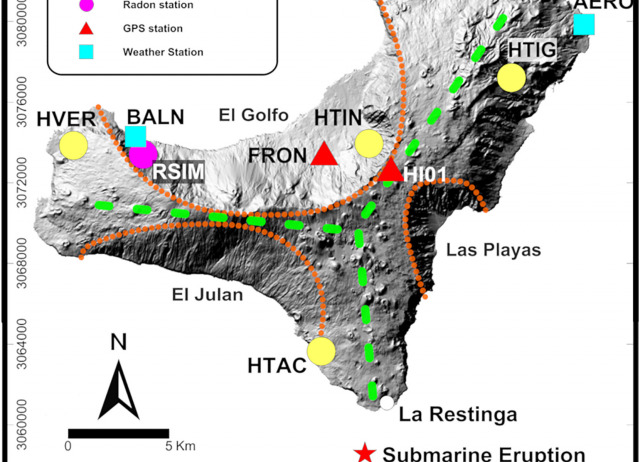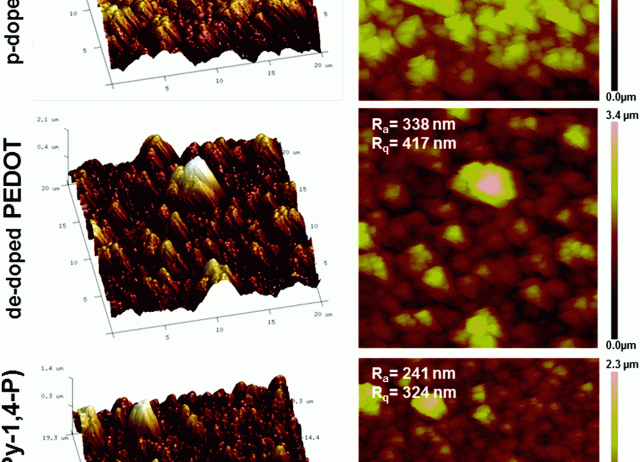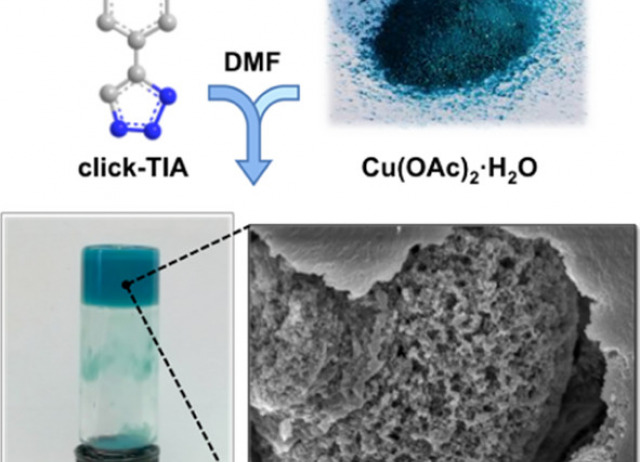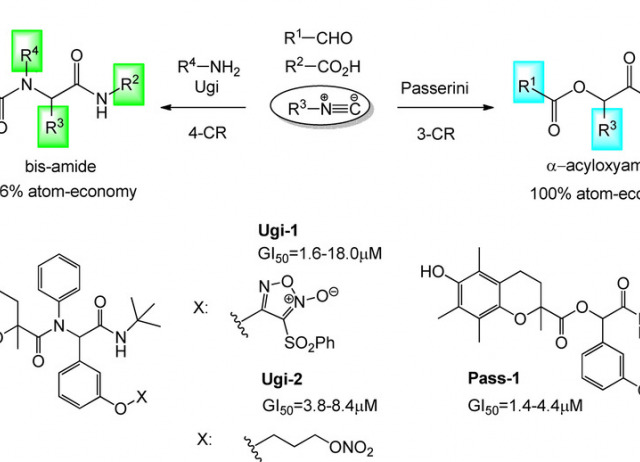
A Focused Library of NO-Donor Compounds with Potent Antiproliferative Activity Based on Green Multicomponent Reactions
Cancer is the second leading cause of death worldwide. Herein, a strategy to quickly and efficiently identify novel lead compounds to develop anticancer agents, using green multicomponent reactions followed by antiproliferative activity and structure–activity relationship studies, is described. A second-generation focused library of nitric oxide-releasing compounds was prepared by microwave-assisted Passerini and Ugi reactions. Nearly all compounds displayed potent antiproliferative activities against a panel of human solid tumor cell lines, with 1-phenyl-1-[(tert-butylamino)carbonyl]methyl 3-[(3-phenylsulfonyl-[1,2,5]oxadiazol-4-yl N-oxide)oxy]benzoate (4 k) and N-[1-(tert-butylaminocarbonyl)-1-phenylmethyl]-N-(4-methylphenyl)-3-(3-phenylsulfonyl-[1,2,5]oxadiazol-4-yl N-oxide)oxyphenyl carboxamide (6 d) exhibiting the strongest activity on SW1573 lung cell line (GI=110 and 21 nm) with selectivity indices of 70 and 470, respectively. Preliminary mechanistic studies suggest a relationship between NO release and antiproliferative activity. Our strategy allowed the rapid identification of at least two molecules as future candidates for the development of potent antitumor drugs
Ingold, Marina; Colella, Lucía; Hernández, Paola; Batthyány, Carlos; Tejedor, David; Puerta, Adrian; García-Tellado, Fernando; Padrón, José M.; Porcal, Williams; López, Gloria V.
Phylogenetic inferences on West Mediterranean Ditomina (Coleoptera: Carabidae: Harpalini) based on molecular data
Ditomina is a subtribe of ground beetles included in the large tribe Harpalini, with most species restricted to the Mediterranean basin. To date, affinities within Harpalini have mainly been derived from morphological data, and the placement of several genera within Ditomina has been subject to discussion. In this study we provide a regional molecular phylogeny for Ditomina with representatives from seven of the eight known genera from the West Mediterranean region, the Australian Phorticosomus Schaum, 1862, and selected Harpalini outgroup taxa. DNA sequences from two different markers, the mitochondrial protein coding gene cox1 and the nuclear gene ITS2, were sequenced and analysed from 19 taxa. Molecular phylogenetic analyses consistently support (i) the sister relationship of genera Carterus Dejean, 1830 and Eocarterus Stichel, 1923; (ii) a close relationship among Ditomus Bonelli, 1810, Tschitscherinellus Csiki, 1906 and Odontocarus Solier, 1835, which form a lineage well separated from Dixus Billberg, 1820; and (iii) the exclusion of Graniger Motschulsky, 1864 and the Australian Phorticosomus from the subtribe Ditomina. In addition, phylogenetic trees indicate a vicariance event for the brachypterous genus Eocarterus on both sides of the Strait of Gibraltar, followed by further geographical differentiation in southern Iberia and northern Morocco. This pattern contrasts with the distribution of various fully winged species of ground beetles on both sides of the same barrier, suggesting the role of dispersal limitation in speciation. Finally, a new key to supraspecific taxa of the Ditomina of the West Mediterranean region is provided.
Andújar, Carmelo; Ruíz, Carlos; Serrano, José
Exploring the effect of the irradiation time on photosensitized dendrimer-based nanoaggregates for potential applications in light-driven water photoreduction
Fourth generation polyamidoamine dendrimer (PAMAM, G4) modified with fluorescein units (F) at the periphery and Pt nanoparticles stabilized by L-ascorbate were prepared. These dendrimers modified with hydrophobic fluorescein were used to achieve self-assembling structures, giving rise to the formation of nanoaggregates in water. The photoactive fluorescein units were mainly used as photosensitizer units in the process of the catalytic photoreduction of water propitiated by light. Complementarily, Pt-ascorbate nanoparticles acted as the active sites to generate H2. Importantly, the study of the functional, optical, surface potential and morphological properties of the photosensitized dendrimer aggregates at different irradiation times allowed for insights to be gained into the behavior of these systems. Thus, the resultant photosensitized PAMAM-fluorescein (G4-F) nanoaggregates (NG) were conveniently applied to light-driven water photoreduction along with sodium L-ascorbate and methyl viologen as the sacrificial reagent and electron relay agent, respectively. Notably, these aggregates exhibited appropriate stability and catalytic activity over time for hydrogen production. Additionally, in order to propose a potential use of these types of systems, the in situ generated H2 was able to reduce a certain amount of methylene blue (MB). Finally, theoretical electronic analyses provided insights into the possible excited states of the fluorescein molecules that could intervene in the global mechanism of H2 generation.
Martínez, Natalia P.; Inostroza-Rivera, Ricardo; Durán, Boris; Molero, Leonard; Bonardd, Sebastián; Ramírez, Oscar; Isaacs, Mauricio; Díaz Díaz, David; Leiva, Angel; Saldías, César
Photocatalytic active polymers in organic synthesis
The idea of using covalently bonded photocatalysts (PCs) on polymers or photocatalytic active polymers originated from the need of recyclable catalysts for the transition from photocatalysis in laboratories to industry scale. Compared with commonly used iridium or ruthenium complexes, metal-free polymers are low cost, stable, efficient, and recyclable catalysts. The development of metal-free photocatalytic active, metal-photosensitizer bonded, photosensitizer-cross-linked, and surface-immobilized polymer-supported PCs are discussed in this chapter through respective examples.
Abramov, Alex; Díaz Díaz, David
Antiprotozoal activities of marine polyether triterpenoids
Chagas disease and leishmaniasis are tropical neglected diseases caused by kinetoplastids protozoan parasites of Trypanosoma and Leishmania genera, and a public health burden with high morbidity and mortality rates in developing countries. Among difficulties with their epidemiological control, a major problem is their limited and toxic treatments to attend the affected populations; therefore, new therapies are needed in order to find new active molecules. In this work, sixteen Laurencia oxasqualenoid metabolites, natural compounds 1–11 and semisynthetic derivatives 12–16, were tested against Leishmania amazonensis, Leishmania donovani and Trypanosoma cruzi. The results obtained point out that eight substances possess potent activities, with IC values in the range of 5.40–46.45 µM. The antikinetoplastid action mode of the main metabolite dehydrothyrsiferol (1) was developed, also supported by AFM images. The semi-synthetic active compound 28-iodosaiyacenol B (15) showed an IC 5.40 µM against Leishmania amazonensis, turned to be non-toxic against the murine macrophage cell line J774A.1 (CC > 100). These values are comparable with the reference compound miltefosine IC 6.48 ± 0.24 and CC 72.19 ± 3.06 μM, suggesting that this substance could be scaffold for development of new antikinetoplastid drugs.
Díaz-Marrero, Ana R. ; López-Arencibia, Atteneri; Bethencout-Estrella, Carlos J.; Cen-Pacheco, Francisco; Sifaoui, Ines; Hernández Creus, Alberto; Duque-Ramírez, María Clara; Souto, María L.; Hernández Daranas, Antonio ; Lorenzo-Morales, Jacob; Piñero, José E.; Fernández, José J.
Environmental temperatures shape thermal physiology as well as diversification and genome-wide substitution rates in lizards
Climatic conditions changing over time and space shape the evolution of organisms at multiple levels, including temperate lizards in the family Lacertidae. Here we reconstruct a dated phylogenetic tree of 262 lacertid species based on a supermatrix relying on novel phylogenomic datasets and fossil calibrations. Diversification of lacertids was accompanied by an increasing disparity among occupied bioclimatic niches, especially in the last 10 Ma, during a period of progressive global cooling. Temperate species also underwent a genome-wide slowdown in molecular substitution rates compared to tropical and desert-adapted lacertids. Evaporative water loss and preferred temperature are correlated with bioclimatic parameters, indicating physiological adaptations to climate. Tropical, but also some populations of cool-adapted species experience maximum temperatures close to their preferred temperatures. We hypothesize these species-specific physiological preferences may constitute a handicap to prevail under rapid global warming, and contribute to explaining local lizard extinctions in cool and humid climates.
Garcia-Porta, Joan; Irisarri, Iker; Kirchner, Martin; Rodríguez, Ariel; Kirchhof, Sebastian; et al.
Chance and predictability in evolution: The genomic basis of convergent dietary specializations in an adaptive radiation
The coexistence of multiple eco-phenotypes in independently assembled communities makes island adaptive radiations the ideal framework to test convergence and parallelism in evolution. In the radiation of the spider genus Dysdera in the Canary Islands, species diversification occurs concomitant with repeated events of trophic specialization. These dietary shifts, to feed primarily on woodlice, are accompanied by modifications in morphology (mostly in the mouthparts), behaviour and nutritional physiology. To gain insight into the molecular basis of this adaptive radiation, we performed a comprehensive comparative transcriptome analysis of five Canary Island Dysdera endemics representing two evolutionary and geographically independent events of dietary specialization. After controlling for the potential confounding effects of hemiplasy, our differential gene expression and selective constraint analyses identified a number of genetic changes that could be associated with the repeated adaptations to specialized diet of woodlice, including some related to heavy metal detoxification and homeostasis, the metabolism of some important nutrients and venom toxins. Our results shed light on the genomic basis of an extraordinary case of dietary shift convergence associated with species diversification. We uncovered putative molecular substrates of convergent evolutionary changes at different hierarchical levels, including specific genes, genes with equivalent functions and even particular amino acid positions. This study improves our knowledge of rapid adaptive radiations and provides new insights into the predictability of evolution.
Vizueta, Joel; Macías-Hernández, Nuria; Arnedo, Miquel A.; Rozas, Julio; Sánchez-Gracia, Alejandro
Geochemical signals related to the 2011–2012 El Hierro submarine eruption
On 10 October 2011, a submarine volcanic eruption began 2 km south of the island of El Hierro (Canary Islands, Spain). It was the first eruption after 40 years of quiescence in the Canarian archipelago. Since mid-July 2011, a multiparametric network has been deployed by the Instituto Geográfico Nacional (hereinafter IGN)to monitor volcanic processes. The data recorded by five stations, measuring the air and soil temperature, CO and radon concentration in the air inside four galleries and one well, are the focus of the present paper. Two important anomalies were found that improve comprehension of the volcanic process. First, a clear increase in CO concentration in one gallery (from 825 ± 19 to 2305 ± 35 ppm)which seems to be mainly controlled by ground deformation measured during the unrest period preceding the eruption. Second, a relationship between radon concentration in air in a well located in the northern side of the island with seismic energy release (several peaks with up to 115% increase), and ground deformation (50% growth in background level), also before the eruption onset. Lastly, changes in radon concentration during eruptive period seem to be modulated by seismic activity (increases up to 233%), which in turn is likely related to variations in magma rheology.
Torres-González, Pedro; Moure-García, David; Luengo-Oroz, Natividad; Villasante-Marcos, Victor; Iribarren, Ilaskiñe; Blanco, M. José; Soler, Vicente ; Jiménez-Abizanda, García-Fraga, José
Antimicrobial activity of poly(3,4-ethylenedioxythiophene) n-doped with a pyridinium-containing polyelectrolyte
In spite of p-doped conducting polymers having been widely studied in the last decades and many applications having been developed, studies based on n-doped conducting polymers are extremely scarce. This fact is even more evident when it comes to conducting polymers n-doped with polycations, even though polyanions, such as poly(styrenesulfonate), are often used to obtain p-doped conducting polymers. In this work poly(pyridinium-1,4-diyliminocarbonyl-1,4-phenylene-methylene chloride), abbreviated as P(Py-1,4-P), has been used to prepare n-doped poly(3,4-ethylenedioxythiophene) (PEDOT) electrodes by applying a reduction potential to a de-doped PEDOT film in a P(Py-1,4-P) water solution. The utilization of this cationic polyelectrolyte as an n-dopant agent results in drastic superficial changes, as is observed by comparing the morphology, topography and wettability of p-doped, de-doped and n-doped PEDOT. Cytotoxicity, cell adhesion and cell proliferation assays, which have been conducted using epithelial and fibroblast cell lines, show that the amount of P(Py-1,4-P) in the re-doped PEDOT films is below that required to observe a cytotoxic harmful response and that n-doped PEDOT:P(Py-1,4-P) films are biocompatible. The non-specific bacteriostatic properties of n-doped PEDOT:P(Py-1,4-P) films have been demonstrated against E. coli and S. aureus bacteria (Gram-negative and Gram-positive, respectively) using bacterial growth curves and adhesion assays. Although the bacteriostatic effect is in part due to the conducting polymer, as is proved by results for p-doped and de-doped PEDOT, the incorporation of P(Py-1,4-P) through the re-doping process greatly enhances this antimicrobial behaviour. Thus, only a small concentration of this cationic polyelectrolyte (∼0.1 mM) is needed to inhibit bacterial growth.
Sánchez-Jiménez, Margarita; Estrany, Francesc; Borràs, Nuria; Maiti, Binoy; Díaz Díaz, David ; Del Valle, Luis J.; Alemán, Carlos
5-(1 H-1,2,3-Triazol-5-yl)isophthalic Acid: A Versatile Ligand for the Synthesis of New Supramolecular Metallogels
The gelation ability of 5-(1H-1,2,3-triazol-5-yl)isophthalic acid (click-TIA) in the presence of different metal acetates has been studied in different solvents and ligand/metal ratios. This manuscript is focused on the metallogel obtained from the combination of click-TIA and copper(II) acetate, which has been used as a model system in terms of characterization and gelation studies. Sonication treatment of the initial mixture of compounds and the nature of the counter anion were found to be critical factors for the supramolecular assembly of the metal/click-TIA complexes and, hence, for the formation of stable and homogeneous metallogels. The gel materials have been characterized with a variety of techniques including infrared, rheology, UV-vis spectroscopy, powder X-ray diffraction, and scanning electron microscopy.
Häring, Marleen; Nandi, Sujay Kumar; Rodríguez-López, Julio; Haldar, Debasish; Martín, Victor S.; Lozano-Gorrín, Antonio Diego D.; Saldías, César; Díaz Díaz, David

